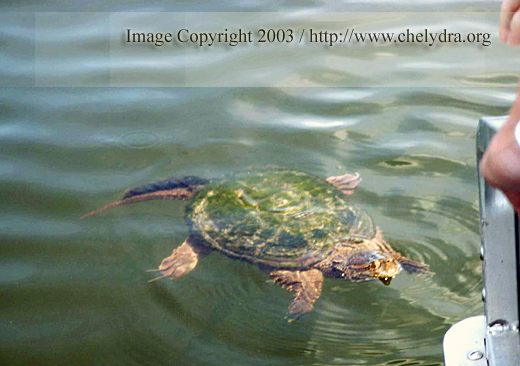The common snapping turtle can be described as highly aggressive when defending itself.
Whenever picked up or molested, the snapper shoots its head forward with incredible speed, its mouth wide open.
The jaws close with a loud crunch when the neck reaches its full length, and if it happens to
grab something it doesn't let go easily. The snapper's bite is strong, and since their jaws are made not to crush but to cut,
even a small snapper can deliver a painfull wound. Larger snappers are easily capable of
removing a person's fingers.
When bothered, snappers produce an odorous substance from organs located on the sides of
the plastron. This reaction disappears in most captive animals used to being handled.
Although snapping turtles are aggressive when defending themselves they are actually quite shy animals,
preferring to quickly swim away whenever approached.
Below is a photo of a quite large adult snapping turtle showing obvious signs of curiosity. Or perhabs it
has been released into the wild and associating people with food it came around to score a snack. In either
case, judging by the growth of algea on it's tail the turtle has been on it's own for a long time.
This kind of behaviour suggests intelligence and lots of personality. And of course it does not support the
'aggressive snapper' theory - they are not out there just to get us !
The below photo was taken by Diane Bell and here is what she had to say about it:
'(...) he was spotted on a small lake in Wisconsin. He came right up at us, apparently
begging for food, but otherwise does not seem aggressive. (...)'
Encounters like this are very exciting, but unfortunately they often end up tragic for many of the turtles,
which get killed on purpose by ignorant people or accidentally get run over by the engine propelled boats. If releasing a
snapping turtle it is a wise idea to find a secluded place far away from the public access and at the best
with already established snapping turtle population.

Considering the turtle's predatory nature, they are not really vicious.
Their " snap " is not an act af aggression, but a defense mechanism, which comes
from the way snappers hunt - approaching prey with a slow motion walking movement and
grabbing it in the blink of an eye. Their speed is so fantastic, it is hard to tell sometimes
when the passing by fish has disappeared. With many fish in a school a snapper is capable of catching two or three in one strike!
Just as a thought - don't many of the animals admired by us live the same way ?
How about bears, birds, tigers etc., but we all love them. And how about cats ? With their
way of hunting and defending themselves when bothered, don't they resemble snapping turtles ? Well,
I know we can't pet a snapping turtle, but cats and turtles both have the same will to survive and bear
offspring. Snapping turtles are not vicious creatures hurtling up our doorsteps and trying to eat
us alive.
Thus, they should be treated
with the respect they deserve, and of course... handled with care.
They too, are wonders of nature and have the right to live.
|